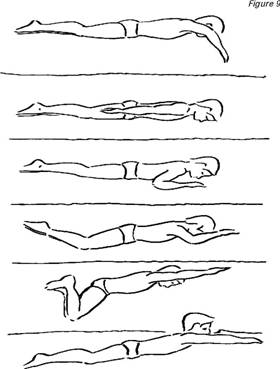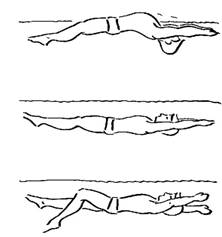


UNDERWATER ACTION (gliding)
Front Crawl
As the glide slows down to swimming speed, the need to start the full stroke will occur. First the leg action is introduced, accompanied by a one arm pull to assist the swimmer to the surface where the full stroke action begins.
Breaststroke
The angle of entry for this stroke is deeper than that for front crawl. This enables the swimmer, while under water, to complete the single arm stroke followed by the one leg kick which is permitted by ASA law (Figure 9 a – f). This law also requires that some part of the swimmer’s head must be above the surface before the second arm stroke begins.

Butterfly
The dive for this stroke is not as steep as that required for breaststroke. ASA law states that the movements of the feet shall be made in a simultaneous manner and also that at the start and at the turn one or more kicks are allowed under water. However, only one arm action is permitted before the swimmer surfaces.
The Back Crawl Start
The starting position for this stroke is in the water, with the swimmer facing the starting end with hands on the end rail or starting grips, and the feet completely beneath the surface
Entry
With the body fully extended, the fingers lead the arms into a streamlined entry. This entry should be a shallow one.
Glide
As with all the front starts, the speed derived from the momentum of take-off is normally greater than the swimming speed. Full advantage should be taken of this by holding the stretched body position. The depth of the glide is controlled by raising or lowering the head, and the leg kick begins as the speed of the glide diminishes to swimming speed. To break the surface, the swimmer pulls through to the side with one arm, keeping the other close to the head in an extended position. Once the face is above the water, the swimmer pulls with the extended arm to start the full stroke.

